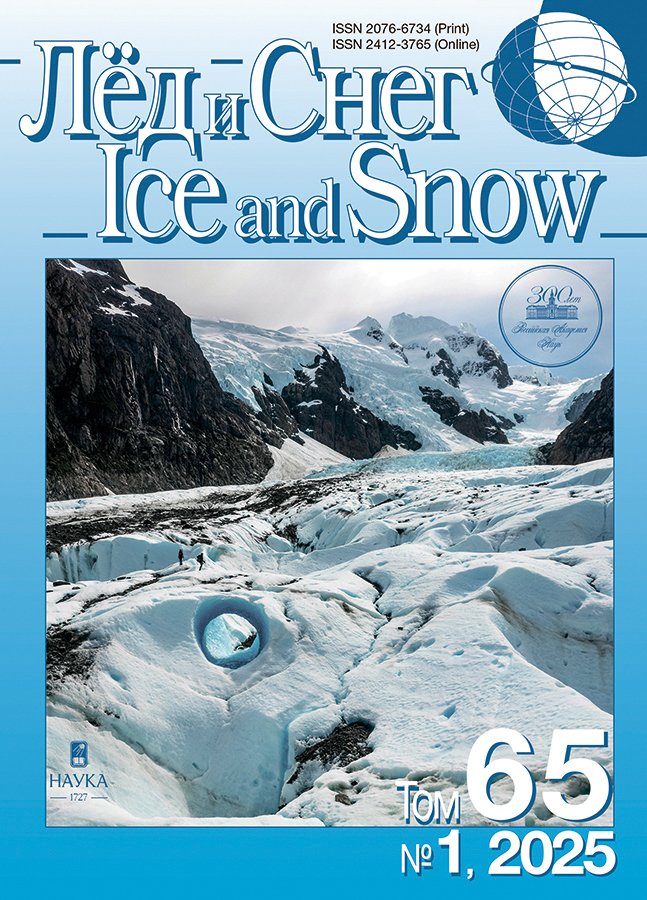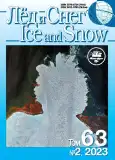Conditions on the Bedrock and Surface of the Vavilov Ice Cap (Severnaya Zemlya) During its Surge According To Airborne Radar Data
- Authors: Glazovsky A.F.1, Kabanov N.A.2, Macheret Y.Y.1, Soldatenko A.M.2
-
Affiliations:
- Institute of Geography, Russian Academy of Sciences
- Lomonosov Moscow State University
- Issue: Vol 63, No 2 (2023)
- Pages: 174-187
- Section: Glaciers and ice sheets
- URL: https://journals.rcsi.science/2076-6734/article/view/137462
- DOI: https://doi.org/10.31857/S2076673423020072
- EDN: https://elibrary.ru/RUMMLO
- ID: 137462
Cite item
Full Text
Abstract
The glacier surge at Vavilov Ice Cap, Severnaya Zemlya, Russia (79°18′ N, 94°40′ E) began as early as the mid-1960s with a slow advance of its margin in the western part. Since 2012, the advance switched to the phase of catastrophic movement, which reached its climax in 2016, when the glacier velocity reached 9.2 km a‒1. An ice fan with an area of about 140 km2 advanced into the Kara Sea water area 11 km from the shore, and a strongly crevassed ice stream was formed in the ice cap itself, which continues to move now with speeds of about 2 km a‒1. The dynamic instability of Vavilov Ice Cap can be triggered by changes in basal conditions, which are still poorly known. In this study, we used airborne radio-echo sounding data acquired in September 2014 over the ice cap to characterize its surface and bedrock conditions. Based on the delay time and reflection amplitudes, the power reflection coefficient (PRC) from glacier surface and bedrock was estimated. For its calibration, we used the amplitude of reflections from the sea surface registered from different altitudes. The bedrock PRC values were converted to dielectric permittivity and compared with the glacier surface velocities in 2014 obtained from Landsat-7 images. We found a high positive correlation between the bedrock PRCs and velocities in the area with glacier speed higher than 1000 m a-1. In this area, the PRC is 20 dB higher than in the neighboring slower moving areas. Such a difference may be because the ice stream advanced on marine loose sediments with higher dielectric permittivity and conductivity and a higher reflection coefficient. The range of estimated bedrock PRCs corresponds to bed materials with relative dielectric permittivity from 5 to 10 and electrical conductivity from 10–5 to 10–2 Sm m‒1.
About the authors
A. F. Glazovsky
Institute of Geography, Russian Academy of Sciences
Author for correspondence.
Email: glazovsky@igras.ru
Russia, Moscow
N. A. Kabanov
Lomonosov Moscow State University
Email: glazovsky@igras.ru
Russia, Moscow
Yu. Ya Macheret
Institute of Geography, Russian Academy of Sciences
Email: glazovsky@igras.ru
Russia, Moscow
A. M. Soldatenko
Lomonosov Moscow State University
Email: glazovsky@igras.ru
Russia, Moscow
References
- Bushueva I.S., Glazovsky A.F., Nosenko G.A. Surge development in the western sector of the Vavilov Ice Cap, Severnaya Zemlya, 1963–2017. Led i Sneg. Ice and Snow. 2018, 58 (3): 293–306 [In Russian]. https://doi.org/10.15356/2076-6734-2018-3-293-306
- Kulnitsky L.M., Gofman P.A., Tokarev M.Yu. Mathematical processing of georadar data and RADEXPRO system. Razvedka i okhrana nedr. Prospect and Protection of mineral resources. 2001, 3: 6–11 [In Russian]
- Macheret Yu.Ya., Glazovsky A.F., Vasilenko E.V., Lavrentiev I.I., Matskovsky V.V. Comparison of hydrothermal structure of two glaciers in Spitsbergen and Tien Shan based on radio-echo sounding data. Led i Sneg. Ice and Snow. 2021, 61 (2): 165–178 [In Russian]. https://doi.org/10.31857/S2076673421020079
- Sochnev O.Ya., Kornishin K.A., Tarasov P.A., Sal’man A.L., Glazovsky A.F., Lavrentiev I.I., Efimov Ya.O., Mamedov T.Ye. Study of glaciers in Russian Arctic for providing of iceberg safety of work on sea shelf. Neftianoe hoziaystvo. Oil Economy 2018, 10: 92–97 [In Russian]. https://doi.org/10.24887/0028-2448-2018-10-92-97
- Bamber J.L. Ice/bed interface and englacial properties of Svalbard ice masses deduced from airborne radio echo-sounding data. Journ. of Glaciology. 1989, 35 (119): 30–37. https://doi.org/10.3189/002214389793701392
- Bentley C.R., Lord N., Liu C. Radar reflections reveal a wet bed beneath stagnant Ice Stream C and a frozen bed beneath ridge BC, West Antarctica. Journ. of Glaciology. 1998, 44 (146): 149–155. https://doi.org/10.3189/S0022143000002434
- Cacitua G., Urde J.A., Wiilson R., Leriaux T., Hernandez J., Rivera A. 50 MHz helicopter-borne data for determination of glacier thermal regime in the central Chilean Ands. Annals of Glaciology. 2015, 56 (70): 193–201. https://doi.org/10.3189/2015Ao670A953
- Chu W., Schroeder D.M., Seroussi H., Creyts T.T., Pal-mer S.J., Bell R.E. Extensive winter subglacial water storage beneath the Greenland Ice Sheet. Geophysical Research Letters. 2016, 43 (24): 12484–12492. https://doi.org/10.1002/2016GL071538
- Chu W., Hilger A.M., Culberg R., Schroeder D.M., Jordan T.M., Seroussi H., Young D.A., Blankenship D.D., Vaughan D.G. Multi-System Synthesis of Radar Sounding Observations of the Amundsen Sea Sector from the 2004–2005 Field Season. Journ. of Geophysical Research Earth Surface. 2021, 126: e2021JF006296. https://doi.org/10.1029/2021JF006296
- Chu W., Schroeder D.M., Seroussi H., Creyts T.T., Pal-mer S.J., Bell R.E. Extensive winter subglacial water storage beneath the Greenland Ice Sheet. Geophysical Research Letters. 2018, 123: 985–995. https://doi.org/10.1029/2017JF004561
- Daniels D.J. (ed.) Ground Penetrating Radar. 2nd Edition. The institution of electrical engineers. 2004: 723 p.
- Dowdeswell J.A., Gorman M.R., Glazovsky A., Macheret Yu.Ya. Airborne radio-echo sounding of the ice caps on Franz Josef Land in 1994. Materialy Glyatsiologicheskikh Issledovaniy. Data of Glaciological Studies. 1996, 80: 248–255.
- Fujita S., Holmlund P., Matsuoka K., Enomoto H. Fukui K., Nakazawa F., Sugiyama S., Surdyk S. Radar diagnosis of the subglacial conditions in Dronning Maud Land, East Antarctica. The Cryosphere. 2012, 6: 1203–1219. https://doi.org/10.5194/tc-6-1203-2012
- MacGregor J.A., Li J., Paden J.D., Catania G.A., Clow G.D., Fahnestock M.A., Gogineni S.P., Grimm R.E., Morlighem M., Nandi S., Seroussi H., Stillman D.E. Radar attenuation and temperature within the Greenland Ice Sheet. Journ. Geophys. Res. Earth Surf. 2015, 120: 983–1008. https://doi.org/10.1002/2014JF003418
- Modified Copernicus Sentinel data/Sentinel Hub. 2014. Retrieved from: https://apps.sentinel-hub.com/eo-browser , Sinergise Ltd. (Last access: 26 January 2022)
- Pettersson R., Christoffersen P., Dowdeswell J.A., Pohjola V., Hubbar A. Strozz T. Ice thickness and basal conditions of Vestfonna Ice Cap, Eastern Svalbard. Geografiska Annaler Series A Physical Geography. 2011. 93: 311–322. https://doi.org/10.1111/j.1468-0459.2011.00438.x
- Rutishauser A., Blankenship D.D., Young D.A., Wolfenbarger N.S., Beem L.H., Skidmore M.L., Dubnick A., Criscitiell A.S. Radar sounding survey over Devon Ice Cap indicates the potential for a diverse hypersaline subglacial hydrological environment. The Cryosphere. 2022, 16: 379–395. https://doi.org/10.5194/tc-16-379-2022
- Schlegel R., Murray T., Smith A.M., Brisbourne A.M., Booth A.D., King E.C., Clark R.A. Radar derived subglacial properties and landforms beneath Rutford Ice Stream, West Antarctica. Journ. of Geophysical Research Earth Surface, 2022, 127: e2021JF006349. https://doi.org/10.1029/2021JF006349/
- Tulaczyk S.M., Foley N.T. The role of electrical conductivity in radar wave reflection from glacier beds. The Cryosphere. 2020, 14: 4495–4506. https://doi.org/10.5194/tc-14-4495-2020
- Van Wyk de Vries M., Wickert A.D. Glacier Image Velocimetry: an open-source toolbox for easy and rapid calculation of high-resolution glacier velocity fields. The Cryosphere. 2021, 15: 2115–2132. https://doi.org/10.5194/tc-15-2115-2021
- Vasilenko E.V., Machio F., Lapazaran J.J., Navarro F.J., Frolovsky K. A compact lightweight multipurpose ground-penetrating radar for glaciological applications. Journ. of Glaciology. 2011, 57 (206): 1113–1118. https://doi.org/10.3189/002214311798843430
- Willis M.J., Zheng W., Durkin IV W.J., Pritchard M.E., Ramage J.M., Dowdeswell J.A., Benham T.J., Bassford R.P., Stearns L.A., Glazovsky A.F., Macheret Y.Y., Porter C.C. Massive destabilization of an Arctic ice cap. Earth and Planetary Science Letters. 2018, 502: 146–155. https://doi.org/10.1016/j.epsl.2018.08.049
- Zheng W., Pritchard M.E., Willis M.J., Stearns L.A. The possible transition from glacial surge to ice stream on Vavilov Ice Cap // Geophysical Research Letters. 2019, 46: 13892–13902. https://doi.org/10.1029/2019GL084948
Supplementary files
















